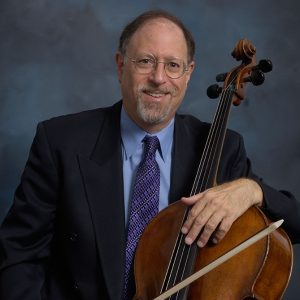
100 Cello Warm-Ups and Exercises Blog 10: Mentalization and Mimes Part 2
Robert Jesselson
 As I mentioned in Part One of this blog on “Mentalization and Mimes”, I have found that in learning or relearning a physical task it is often very helpful to do it away from the cello. There are several ways that we can retrain our bodies, including through visualization, biofeedback, using a “phantom cello”, and with mimes. I discussed the benefits of visualization, or what I call Mentalization. Here is a practical example of how to do this: Sit in a quiet place and take a few deep breaths to relax. Then imagine the beginning of a piece you are working on. Hear, feel and see the music in your mind. Do not actually move your fingers, but imagine the coordination between the left hand and the bow arm. Feel the shape of the first phrase, and what you need to do with the bow to achieve the musical line that you are imagining. You may find that you can only do a few measures this way, even in a piece that you “know” very well. That’s fine – just take a look at the music, and then try it again. After a few days repeating this kind of work you will find that you will have built up the concentration and focus that you need to get through larger and larger sections of the piece.
As I mentioned in Part One of this blog on “Mentalization and Mimes”, I have found that in learning or relearning a physical task it is often very helpful to do it away from the cello. There are several ways that we can retrain our bodies, including through visualization, biofeedback, using a “phantom cello”, and with mimes. I discussed the benefits of visualization, or what I call Mentalization. Here is a practical example of how to do this: Sit in a quiet place and take a few deep breaths to relax. Then imagine the beginning of a piece you are working on. Hear, feel and see the music in your mind. Do not actually move your fingers, but imagine the coordination between the left hand and the bow arm. Feel the shape of the first phrase, and what you need to do with the bow to achieve the musical line that you are imagining. You may find that you can only do a few measures this way, even in a piece that you “know” very well. That’s fine – just take a look at the music, and then try it again. After a few days repeating this kind of work you will find that you will have built up the concentration and focus that you need to get through larger and larger sections of the piece.
Mimes
Sometimes we need to rethink the basic physical approaches to playing the cello. I have found that one of the best techniques for learning or relearning a physical task is to do it away from the cello. In other words when you are trying to figure out how to bow parallel to the bridge, or how the arm moves in a shift, or how the vibrato motion works, it is helpful to learn those motions without actually playing. By stripping away all the complexities of the music, we can focus on the physicality of the task by silently miming the activity. When playing the cello we can easily get distracted by a myriad of other factors: intonation, tone color, and bad habits not directly related to the task at hand. As a result it is sometimes difficult to relearn a task. Mimes can help us figure out how the arm or hand should move without being distracted by anything else. Once we have learned the proper physical approach we can return to the cello with new neural pathways superseding the old bad habits.
Biofeedback
Another method for training and retraining the body is through Biofeedback. This is especially effective in learning to relax muscles. Biofeedback is a technique used to control the body’s responses to physical and emotional stress. Information about tension is “fed back” to the individual immediately, thereby enabling physical changes to be made in response. As a result, individuals can train themselves to relax certain parts of the body as required.
Biofeedback is pertinent to musicians as it can help reduce tension in playing, alleviate performance anxiety, and address other serious underlying physical problems such as tendonitis. Use of a biofeedback machine, and the underlying principles of relaxation, can help sensitize musicians to understand and use their bodies better, and help to re-train them to play with less tension and more accuracy.
I participated in a study in 1981 that showed that EMG (electromyography) feedback was found to be a successful mechanism for helping musicians to reduce specific muscle tension during performance. Until recently, biofeedback machines were large and unwieldy, and few people had the opportunity to use them. They were only accessible in laboratories and for use with assistance from physical therapists. Now, however, smaller portable machines have become available. I have used these with my students, including Myotrac for EMG, and emWave for HRV. I have found them to be very helpful in sensitizing cellists to reduce tension in specific muscles.
Playing the cello is a physical activity, but we have to remember that it is also “mind over matter”. What we are really training is the brain.
Next week’s blog will start a two-part series on Flexibility and Coordination.
Subjects: Practicing, Technique
